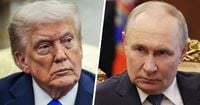On October 25, 2025, the United States sent a shockwave through global energy markets by imposing sweeping new sanctions on Russia’s petroleum industry, marking the first major move against Moscow’s oil sector since Donald Trump’s return to the White House. The decision, which came alongside similar measures from Europe, immediately triggered chaos in the oil market: crude prices spiked by 6%, Indian refiners—the lifeblood of Russia’s post-2022 export strategy—declared a halt to Russian oil purchases, and even some Chinese buyers hit the brakes, at least temporarily, according to Bloomberg.
For a world already grappling with geopolitical instability and inflationary pressures, the timing and scale of these sanctions are hard to overstate. As reported by MarketWatch, oil prices recorded their biggest weekly gain since June, raising the specter of higher costs for U.S. consumers at the pump. This is especially striking given President Trump’s longstanding pledge to keep energy prices low—a promise now seemingly at odds with his administration’s strategy to punish Russia for its ongoing war in Ukraine.
At the heart of the new sanctions are Russia’s two largest crude producers, Rosneft and Lukoil, which together account for roughly half of the nation’s oil output. The measures cut these companies off from much of the global financial system and threaten penalties for any entities that continue buying Russian oil. Analysts cited by The New York Times suggest the move is designed to pressure the Kremlin into halting its campaign of attacks on Ukraine’s power grid and considering a limited cease-fire on energy targets. But the ripple effects are global: tighter oil supplies could squeeze economies from Europe to Asia, and American drivers may soon feel the pain at the gas station.
The sanctions come at a moment when the war between Russia and Ukraine has entered a grueling, attritional phase. With the front lines largely deadlocked, both sides have turned to energy infrastructure as a new battleground. Ukraine, for its part, has launched a series of drone strikes that have damaged dozens of Russian refineries, aiming to cripple the Kremlin’s war machine by targeting the very assets that fund it. As The New York Times details, these attacks have destroyed or damaged about 20% of Russia’s refining capacity, leading to gasoline shortages in several Russian regions and bringing the costs of war closer to ordinary Russians.
Russia has responded in kind, escalating its campaign against Ukrainian electricity and gas infrastructure just as winter approaches. The goal, according to experts, is to plunge Ukrainian cities into darkness and cold, undermining morale and straining the country’s already battered economy. In the past week, Ukraine has rolled out emergency blackouts in cities like Chernihiv, where total power loss has disrupted public transportation and water supplies. The stakes are high: with subzero temperatures looming, many Ukrainian households now face the prospect of insufficient heat, a grim echo of previous winters under siege.
“Today, we face the challenge of going through the most difficult heating season of all the years of the full-scale war,” Kyiv’s mayor, Vitali Klitschko, told reporters on Thursday, as cited by The New York Times. Factories across Ukraine are also at risk, with power shortages and soaring electricity costs threatening to shut down production and drive more citizens to seek refuge abroad. Katharina Reiche, Germany’s economy minister, noted during a visit to Kyiv, “We are already seeing more refugees from Ukraine in Germany.”
On the Russian side, the new sanctions are expected to test the resilience of an economy that has, until now, weathered Western restrictions by pivoting to markets in China and India and exploiting various loopholes. But this latest round goes further than previous efforts, striking at the core of Russia’s wealth—an oil sector that generates hundreds of millions of dollars daily, funding both the replacement of battlefield equipment and the recruitment of soldiers. Jack Watling, a research fellow at the Royal United Services Institute, summed it up: “In terms of both equipment and personnel, the key to Russia’s ability to rebuild combat power is money, which is overwhelmingly generated through the oil and gas sector.”
There are already signs of economic strain in Moscow. For the first time since the war began, Russia’s military spending is projected to decline in 2026, raising questions about the sustainability of its war effort. President Vladimir Putin acknowledged the pain of the new sanctions, admitting they would hurt the economy, but insisted the Kremlin’s resolve would not waver. President Trump, however, suggested that Moscow might feel differently in six months, once the full impact of the measures becomes clear. “Let’s see how it all works out,” Trump told reporters, according to The New York Times.
Beyond the economic front, Ukraine’s military has also struck deep into Russian territory using Western-supplied Storm Shadow missiles, targeting facilities that produce explosives and rocket fuel. These weapons rely on American satellite data, indicating tacit U.S. approval for their use inside Russia—a move that has drawn increasingly sharp warnings from the Kremlin. Kyiv is now pushing for access to even longer-range U.S. Tomahawk missiles, but Trump has so far held back, wary of further escalation.
Meanwhile, Ukraine’s own energy woes are mounting. Russian attacks have knocked out about 60% of the country’s gas production capacity and crippled key compressor stations needed to move stored gas. With European partners themselves facing budget crunches, it remains unclear whether Ukraine will secure the $2 billion needed to import enough gas to get through the winter. A European plan to use frozen Russian assets to lend Ukraine $163 billion, enough to cover its financial needs for the next two years, hangs in the balance amid legal and political wrangling.
As winter sets in and ground combat slows, analysts expect the energy war to remain the most active—and perhaps decisive—front in the conflict. Both sides are gambling that economic pain will force the other to the negotiating table, but so far, neither appears ready to blink. Moscow continues to demand that Kyiv cede all occupied territories, while Ukraine insists on a cease-fire that freezes the current front line—a position Russia rejects outright.
In the end, the U.S. and European sanctions may mark a turning point in the conflict, but whether they bring peace or simply deepen the hardship remains to be seen. For now, ordinary citizens from Saint Petersburg to Kyiv are bracing for a winter shaped not just by the cold, but by the high-stakes energy war raging behind the headlines.


